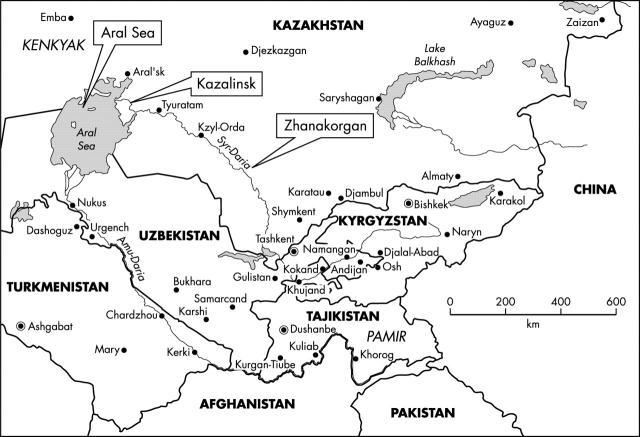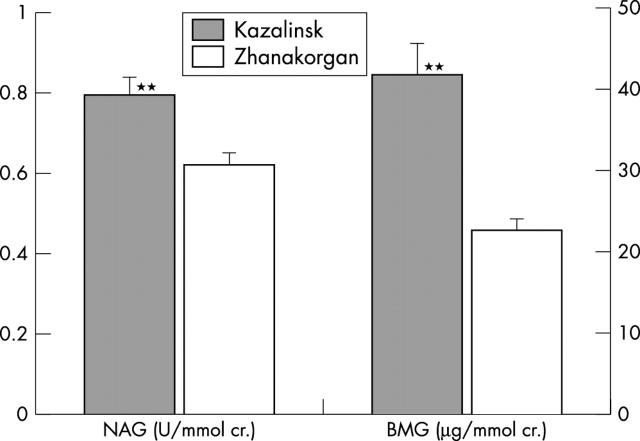Abstract
Background: The Aral Sea region is a natural area seriously polluted by human activities. Recent surveillance revealed the increased prevalence of diverse chronic diseases in children.
Aims: To investigate the function of renal tubules, which are most at risk of damage as a result of heavy metal intoxication, in children of the Aral Sea region.
Methods: A group of 205 children living in Kazalinsk, close to the Aral Sea, and a group of 187 children living in Zhanakorgan, far from the Aral Sea, were examined by means of random urine samples. Both urinary N-acetyl-ß-D-glucosaminidase (NAG; U/mmol Cr) and ß2 microglobulin (BMG; µg/mmol Cr) were calculated for each subject.
Results: Mean urinary NAG and BMG were both significantly higher in Kazalinsk than in Zhanakorgan (NAG: 0.77 (0.58) and 0.62 (0.37) U/mmol Cr; BMG: 41.8 (54.8) and 22.5 (20.4) µg/mmol Cr, respectively; mean (SD), p < 0.01). The number of children with abnormal values of NAG (>1.5 U/mmol Cr) was significantly more prevalent in Kazalinsk than in Zhanakorgan (7.9% and 2.6%, respectively, p < 0.05).
Conclusion: Renal tubular function of children around the Aral Sea region is profoundly impaired. This should be taken into account when considering the health problems of this area.
Full Text
The Full Text of this article is available as a PDF (262.0 KB).
Figure 1 .
Study areas in Republic of Kazakhstan.
Figure 2 .
Mean urinary BMG (µg/mmol creatinine) and NAG (U/mmol creatinine) of children of the Aral Sea region (Kazalinsk) and the control region (Zhanakorgan). Error bars indicate SEM. **p < 0.01 (difference between regions).
Selected References
These references are in PubMed. This may not be the complete list of references from this article.
- Ataniyazova O. A., Baumann R. A., Liem A. K., Mukhopadhyay U. A., Vogelaar E. F., Boersma E. R. Levels of certain metals, organochlorine pesticides and dioxins in cord blood, maternal blood, human milk and some commonly used nutrients in the surroundings of the Aral Sea (Karakalpakstan, Republic of Uzbekistan). Acta Paediatr. 2001 Jul;90(7):801–808. [PubMed] [Google Scholar]
- Jensen S., Mazhitova Z., Zetterström R. Environmental pollution and child health in the Aral Sea region in Kazakhstan. Sci Total Environ. 1997 Nov 5;206(2-3):187–193. [PubMed] [Google Scholar]
- Kaneko K., Chiba M., Hashizume M., Kunii O., Sasaki S., Shimoda T., Yamashiro Y., Dauletbaev D., Caypil W., Mazhitova Z. Extremely high prevalence of hypercalciuria in children living in the Aral Sea region. Acta Paediatr. 2002;91(10):1116–1120. doi: 10.1080/080352502760311638. [DOI] [PubMed] [Google Scholar]
- Liu C. S., Kuo H. W., Lai J. S., Lin T. I. Urinary N-acetyl-beta-glucosaminidase as an indicator of renal dysfunction in electroplating workers. Int Arch Occup Environ Health. 1998 Jul;71(5):348–352. doi: 10.1007/s004200050291. [DOI] [PubMed] [Google Scholar]
- Mazhitova Z., Jensen S., Ritzén M., Zetterström R. Chlorinated contaminants, growth and thyroid function in schoolchildren from the Aral Sea region in Kazakhstan. Acta Paediatr. 1998 Sep;87(9):991–995. doi: 10.1080/080352598750031671. [DOI] [PubMed] [Google Scholar]
- Nishida M., Kawakatsu H., Komatsu H., Ishiwari K., Tamai M., Tsunamoto K., Kasubuchi Y., Sawada T. Values for urinary beta 2-microglobulin and N-acetyl-beta-D-glucosaminidase in normal healthy infants. Acta Paediatr Jpn. 1998 Oct;40(5):424–426. doi: 10.1111/j.1442-200x.1998.tb01961.x. [DOI] [PubMed] [Google Scholar]
- Noonan Curtis W., Sarasua Sara M., Campagna Dave, Kathman Steven J., Lybarger Jeffrey A., Mueller Patricia W. Effects of exposure to low levels of environmental cadmium on renal biomarkers. Environ Health Perspect. 2002 Feb;110(2):151–155. doi: 10.1289/ehp.02110151. [DOI] [PMC free article] [PubMed] [Google Scholar]
- Staessen J. A., Nawrot T., Hond E. D., Thijs L., Fagard R., Hoppenbrouwers K., Koppen G., Nelen V., Schoeters G., Vanderschueren D. Renal function, cytogenetic measurements, and sexual development in adolescents in relation to environmental pollutants: a feasibility study of biomarkers. Lancet. 2001 May 26;357(9269):1660–1669. doi: 10.1016/s0140-6736(00)04822-4. [DOI] [PubMed] [Google Scholar]
- Wu X., Jin T., Wang Z., Ye T., Kong Q., Nordberg G. Urinary calcium as a biomarker of renal dysfunction in a general population exposed to cadmium. J Occup Environ Med. 2001 Oct;43(10):898–904. doi: 10.1097/00043764-200110000-00009. [DOI] [PubMed] [Google Scholar]
- Zamora M. L., Tracy B. L., Zielinski J. M., Meyerhof D. P., Moss M. A. Chronic ingestion of uranium in drinking water: a study of kidney bioeffects in humans. Toxicol Sci. 1998 May;43(1):68–77. doi: 10.1006/toxs.1998.2426. [DOI] [PubMed] [Google Scholar]




